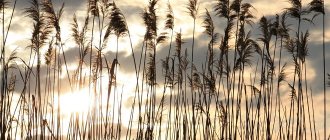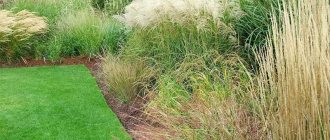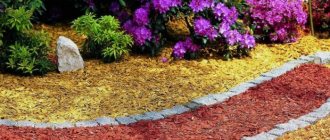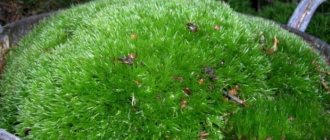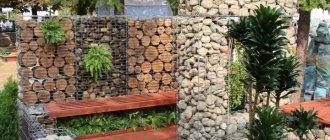The cereal family has more than 10,000 species. They are found on all continents, even in Antarctica. All grain crops belong to this family. The overwhelming majority of the phytomass in the steppes also consists of cereals. The most ancient cultivated plants from which basic necessities are obtained: flour, cereals, sugar, livestock feed, fiber and building materials. Naturally, among ornamental plants there are many cereals.
Types of ornamental grasses
The diverse family of ornamental grasses allows you to create multi-level and multi-colored compositions. They are not whimsical, grow quickly, and are not capricious when combined with other types of plants. Their seasonal transformations from a grass carpet to original inflorescences, and then to snow-covered waves delight the eye throughout the year.
The picturesque compositions in the photo, consisting entirely of ornamental grasses, make us re-evaluate this type of plant for creative experiments.
Rockeries are a derivative of the rocky plain, a memory of mountain meadows. Stones play a very important role in the creation and design of a rock garden, both large boulders, pointed piles, and crushed stone filling of medium and small fractions. Plants for rockeries should be dwarf, low-growing, slow-growing, creeping and climbing. An indispensable attribute of any rock garden are dwarf conifers and junipers.
Watch the video: Ornamental cereals in the garden and country house
Here their role is not limited to filling empty spaces and framing spectacular colors; they come to the fore, striking with their original natural energy and riot of colors.
The names of many ornamental grasses refer to their appearance.
Miscanthus giant, or American reed
If other ornamental grasses are striking in shape or color, then giant miscanthus (Miscanthus giganteus) is striking in size. This unusually large grass grows to a height of about 3 m. And in warm climates it also blooms unusually, releasing pink panicles at the end of summer, which later turn silver.
Miscanthus giganteum is a perennial. Loves warmth, areas open to the sun but protected from the wind, regular abundant watering, fertile soil. Cold-resistant. The most convenient way to propagate it is by dividing the mother plant. Due to the fact that the lower leaves of giant miscanthus die off by the end of the season, this grass looks better in the background of compositions.
Giant miscanthus (Miscanthus giganteus). © Milan Havlis
Blue fescue
Blue fescue is a frost-resistant grass. The original bluish color of this cereal in combination with needle-shaped leaves creates an irresistible airy effect.
It looks good on borders and in flower and stone arrangements, but it needs sun to look beautiful.
Hairy pinnate bristle, or Pennisetum
the feathery bristleweed (Pennisetum villosum) is popularly called “fountain grass”. Both its drooping foliage and the drooping panicles that appear from mid-summer are, in fact, very similar to the jets of a fountain. Thanks to this feature, the presence of pinnately bristle in the composition gives it airiness and a kind of festivity. It is simply impossible to pass by such a garden decoration without paying attention.
Pennisetum is quite unpretentious. Loves sun, fertile, moderately moist soil. Propagated both by seeds and by dividing the mother plant. Thanks to the durability of the panicles, it is a decoration of the garden not only in the summer-autumn period, but also during the winter. Used to form dry bouquets. As a perennial it can only be used in warm climates. In the middle zone and further north it is grown exclusively as a tub or annual plant.
Hairy cirrus bristleweed (Pennisetum villosum). © Ciaran Burke
Feather grass fluffy cloud
Feather grass fluffy cloud is a steppe unpretentious plant that, when growing, turns into original silky bushes; during flowering, the tips of the bush become pink or golden.
Another unusually beautiful variety of cultivated feather grass, “the most beautiful,” has the thinnest stems covered with transparent fluff.
How to choose cereal plants for your summer cottage
Cereal plants in landscape design not only well emphasize the beauty of other plants and fill the pauses during the period when some flowers have already faded, while others are just beginning. They can also lead a “solo part”. Especially in late summer and autumn, when their peak flowering occurs.
When choosing cereals for a site, consider:
- height of plants - too tall ones in the foreground will cover all the others;
- perennial or annual;
- what kind of soil do they like - there are a number of plants that love dry soil or, on the contrary, grow near bodies of water;
- place – light or shade;
- what color the panicles are to achieve the correct color composition.
Mace Bearer
The dense, seemingly bristling bushes of the gray macebearer are ideal for decorating borders 20-30 cm high. This light-loving and fast-growing ground cover plant takes root well in sandy soils of the middle zone.
- Indoor ventilation
Choosing grass for the lawn
Deutzia is blooming - summer is coming
Gray fescue, or Festuka
Gray fescue (Festuca glauca) is difficult to confuse with other ornamental cereal crops. Forming a small, neat, bluish tussock, this plant is an accent plant. Due to its unpretentiousness, it is often used for landscaping city streets, rock gardens, and rock gardens. It is also used to form borders and as a ground cover plant.
Gray fescue is a perennial. Grows on any soil. Tolerates drought well. Not afraid of harsh winters. Propagated by both seed and vegetative methods. It can grow in one place for up to 10 years, but after 2–3 years it somewhat loses its decorative effect due to the death of the center of the bush. For this reason, it requires periodic renewal by dividing the turf.
Gray fescue (Festuca glauca)
Ophiopogon Nigrescens
A favorite of exotic lovers, Ophiopogon Nigrescens, a grass with black leaves, pink flowers and blue-black berries, can be a spectacular addition to exotic lawns, rockeries and alpine slides.
No less picturesque is the ophiopogon variety called Japanese with bright blue berries. This plant does not need winter shelter, is not afraid of temperature changes and wind, but requires maintaining air humidity and regular watering.
American pinnately or pearl millet
Pearl millet (Pennisetum glaucum) is another amazing cereal plant for spectacular landscaping. Its peculiarity lies in the brown-purple foliage and the even darker, almost black color of the cylindrical inflorescences. Thanks to them, pearl millet not only gives the composition a special attractiveness, but also a certain elitism - after all, such a miracle is rarely seen.
American pinnate bristle is an annual plant. A completely unpretentious plant: it grows well in any soil, loves a lot of light, and copes well with a lack of moisture. Easily propagated by seeds. It looks most impressive in group plantings as an accent crop. Can be used for cutting.
Pearl millet or American millet (Pennisetum glaucum). © Sian Matthews
Lightning blue
Blue lightning is another tall grass with glaucous leaves and blue-violet panicles. It also needs moisture, planted together with flowers with a similar growth regime, or decorates the edges of artificial ponds.
Planting trees on the siteKerria or Keria: photo and description of the shrub, rules and subtleties of growing a plant with yellow flowers
Ornamental shrubs in landscape design blooming in autumn
The Miscanthus family deserves special attention. These giant-sized cereals with an erect stem have many varieties that differ in color and shape. This light-loving and moisture-loving plant, with a height of 80 cm to 3 m, needs protection from frost.
Used in mixborders, for decorating ponds, luxurious bushes of Chinese and sucrose miscanthus can become an exquisite decoration of green lawns.
Warm-season cereals
Pampas grass
Warm-season grains require more care than others, but not by much. In our country, it is better to plant these in the southern regions where they will not freeze. This:
- Pampas grass is a plant with panicles of white, cream, pink, pink and purple. Most varieties cannot withstand Russian frosts, but frost-resistant species have now been bred. Loves fertile soil and warmth.
- Imperata cylindrica is a bright grass with thin, bright red tips. By autumn it is completely painted in crimson tones.
- Maned barley has spikelets with long awns . During the flowering period they are pink-violet, when they dry out they are white.
Drought-resistant flowers: Doronicum
The perennial herbaceous plant from the Asteraceae family has the popular name “sunny chamomile” or “kozulnik”. Doronicum flowers resemble a daisy in shape with a fluffy yellow center and long yellow petals in a circle.
Doronicum: YouTube/GARDEN and VEGETABLE VEGETABLE ALL YEAR ROUND
The plant has a superficial fibrous root, so it is better not to loosen the soil around it. The stems grow up to 1 m. Flowering of Doronicum begins in mid-April and continues until the end of June. Yellow flowers open on individual peduncles or form corymbose inflorescences.
The perennial propagates by dividing the bush every four years. “Sunny Chamomile” prefers illuminated areas, is undemanding to the composition of the soil, and continues to bloom even in dry, hot weather.
Pests and diseases
One of the main advantages of sheep is the absence of enemies among pests.
As for diseases, in hot, rainy summers in insufficiently drained soil, the roots of the plant can be affected by fungal infections and rot in winter. In conditions of high humidity and high temperature, the sheep blooms poorly, and by the end of summer it can develop rust. To prevent the plant from being affected by this fungal disease, it is grown in a place well blown by the wind. If signs of rust appear, treat the sheep bush with Bordeaux mixture or another fungicidal preparation.
If there are symptoms of root rot, dig up the shrub and carefully remove the rotting areas from its roots, treat the cuttings with charcoal powder and plant the bush in another place, providing it with good drainage.
Classification
The grass family consists of 900 genera and 11,500 species.
Systematization and classification of one of the largest and most diverse families of higher plants is complicated by the fact that representatives are prone to hybridization and gene mutation (polyploidy). Currently, an international system has been adopted that divides the cereal family into the following subfamilies:
- Bluegrass (Pooideae);
- Feather grasses (Stipoiideae);
- Millets (Panicoideae);
- Bamboo (Bambusoideae);
- Reeds (Arundinoideae);
- Chlorideaceae (Cloridoideae);
- Centotecae (Centothecoideae).
There is also a classification in which the cereal family is divided into two subfamilies: true cereals and bamboo-like ones. A system is used in which cereals are divided into tribes - classification categories below family but above genus. Tribes are divided into subtribes, genera, sections, and species. Some scientists distinguish rice and field grasses into separate subfamilies, and oat plants are considered a separate tribe, and not part of the Poagrass tribe.
Representatives of the Poa subfamily are well-known food crops: wheat, barley, rye. As well as forage and weed plants: oats, wheatgrass, bluegrass, pearl barley, rump. Millet grains include plants such as corn, millet, sugarcane and miscanthus. Chloriceaceae - hog snout and buffalo grass.
Despite the wide variety of species, cereals have common characteristics: fibrous roots, knotty stems, and grain-like fruits. The leaves of cereals form a sheath and a membranous ligule at the base of the leaf. Most stems have a hollow structure between the nodes. Such a stem is called a straw. Cereal inflorescences consist of spikelets that form a panicle, spike, cob or plume. The spikelets have two scales covering the flowers (from one to several). The flower has two scales, one pistil and three stamens. The fruit is a grain in which the seed coat is fused with the pericarp.
Cereals are of great importance , which include all types of wheat, including spelt, kamut and emmer, as well as barley, rye, oats, millet, corn and rice.
There is a wide variety of types of oats, there are more than 70 of them. Of the cultivated oats, two types are common: Byzantine oats and common oats, of the wild ones - southern oats and common oats. Many types of oats are very picturesque and are increasingly used as ornamental grasses for the garden.
Kalanchoe mysterious 'Copper Spoons' (Kalanchoe orgyalis)
Translated, the name means “Copper Spoon,” which refers to the unique shape and color of the succulent’s leaves. The leaf plate seems to be covered with a copper-golden velvet coating on the front part. This coloring is most pronounced on young growth; with age, the foliage becomes green.
It blooms with paniculate yellow inflorescences.
@entireleaves, Flickr
@jayteez, Flickr
Echeveria Doris Taylor
Hybrid from crossing Echeveria pulvinata and Echeveria setosa.
The compact succulent is formed by a branched bush with a short woody stem and branches growing to the sides. The ends of the shoots are crowned with small (up to 5 cm) dense leaf rosettes of bright green color. The leaf is pointed, elongated, covered with short white hair, thicker on young growth.
@sukulen_house, Instagram
@eastcoastplanthoarder, Instagram
Allium
A unique plant for flower beds is the decorative allium. Beautiful flowers appear in the garden in the spring if the bulbs are planted in the ground in the fall. Allium is a light-loving plant that does not require additional watering.
Allium: YouTube/oldenburg
External signs of allium:
- Arrows-peduncles on which multi-colored inflorescences-balls are formed.
- The inflorescences are made up of small star flowers.
- Peduncles grow up to 1.5 m high.
- The petal colors are purple, pink and white.
Allium blooms for up to 2 weeks, and then the flowers and leaves dry out. Therefore, the perennial is planted in the flowerbed next to other flowering plants that overlap the fading onions.
Spirea
The perennial spirea shrub looks beautiful on large flower beds and lawns. A deciduous plant from the rose family, the color of the inflorescences ranges from snow-white to crimson.
There are about 100 species of shrubs. There are early-blooming and late-blooming perennial varieties that bloom in summer.
Spiraea: YouTube/ Hitsad TV
Shrubs of various types grow from 15 cm to 2.5 m, spreading lush branches in all directions. Spiraea inflorescences are made up of small flowers and acquire a spicate, corymbose, paniculate or pyramidal shape. Flowers can be placed along the entire stem or collected at the very end of the branch.
Spiraea reproduces by dividing the bush, layering, cuttings and even seeds. Dwarf bushes are planted to decorate borders, and drought-resistant giant plants are excellent for hedges. Spirea loves sunny areas, does not require additional watering, and tolerates winter well.


